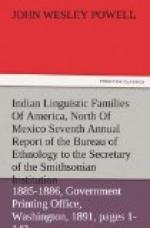The presentation of the name Quoratem, as above, seems sufficiently formal, and it is therefore accepted for the group first indicated by Gibbs.
In 1856 Latham renamed the family Ehnik, after the principal band, locating the tribe, or rather the language, south of the Shasti and Lutuami areas.
GEOGRAPHIC DISTRIBUTION.
The geographic limits of the family are somewhat indeterminate, though the main area occupied by the tribes is well known. The tribes occupy both banks of the lower Klamath from a range of hills a little above Happy Camp to the junction of the Trinity, and the Salmon River from its mouth to its sources. On the north, Quoratean tribes extended to the Athapascan territory near the Oregon line.
TRIBES.
Ehnek.
Karok.
Pehtsik.
Population.—According to a careful estimate made by Mr. Curtin in the region in 1889, the Indians of this family number about 600.
SALINAN FAMILY.
< Salinas, Latham in Trans. Philolog.
Soc. Lond., 85, 1856 (includes
Gioloco, Ruslen, Soledad of Mofras, Eslen,
Carmel, San Antonio, San
Miguel). Latham, Opuscula, 350, 1860.
> San Antonio, Powell in Cont. N.A.
Eth., III, 568, 1877 (vocabulary
of; not given as a family, but kept by
itself).
< Santa Barbara, Gatschet in Mag.
Am. Hist., 157, 1877 (cited here as
containing San Antonio). Gatschet
in U.S. Geog. Surv. W. 100th M.,
VII, 419, 1879 (contains San Antonio,
San Miguel).
X Runsiens, Keane, App. Stanford’s
Comp. (Cent. and So. Am.), 476,
1878 (San Miguel of his group belongs
here).
Derivation: From river of same name.
The language formerly spoken at the Missions of San Antonio and San Miguel in Monterey County, California, have long occupied a doubtful position. By some they have been considered distinct, not only from each other, but from all other languages. Others have held that they represent distinct dialects of the Chumashan (Santa Barbara) group of languages. Vocabularies collected in 1884 by Mr. Henshaw show clearly that the two are closely connected dialects and that they are in no wise related to any other family.
The group established by Latham under the name Salinas is a heterogeneous one, containing representatives of no fewer than four distinct families. Gioloco, which he states “may possibly belong to this group, notwithstanding its reference to the Mission of San Francisco,” really is congeneric with the vocabularies assigned by Latham to the Mendocinan family. The “Soledad of Mofras” belongs to the Costanoan family mentioned on page 348 of the same essay, as also do the Ruslen and Carmel. Of the three remaining forms of speech, Eslen, San Antonio, and San Miguel, the two latter are related dialects, and belong within the drainage of the Salinas River. The term Salinan is hence applied to them, leaving the Eslen language to be provided with a name.




